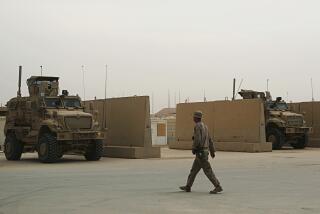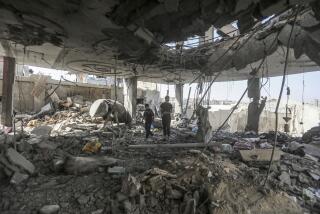U.S. and allies plan to give Afghanistan forces lead role in 2013
- Share via
Reporting from Brussels — The U.S. and its military allies in Afghanistan intend to hand the lead combat role to Afghan forces next year, according to Defense Secretary Leon E. Panetta, shifting to a training and advising mission as they press ahead with their withdrawal after more than a decade of fighting.
By announcing a specific timetable, U.S. officials are hoping to head off a push by allies to pull out their forces more quickly. Public support for the war is falling in many countries, and with their economies struggling, governments are under pressure to trim their defense budgets.
The top commander in Afghanistan, U.S. Marine Corps Gen. John R. Allen, said in December that he was planning such a shift, but Panetta’s comment Wednesday on his way to a NATO meeting in Brussels marked the first time a senior U.S. official had provided a timetable.
The shift to an advisory mission in Afghanistan is similar to the approach used in Iraq, where U.S. troops pulled out of major cities and focused on training Iraqi troops more than a year before leaving for good.
An emphasis on training could keep more troops on bases and help reduce U.S. casualties. The advisory effort would put small teams of U.S. troops with Afghan units to help them plan operations and to call in air support and artillery fire if needed.
It remains unclear how capable the Afghan army and police, which are plagued by corruption, operational and personnel problems, will be to assume the main responsibility for fighting the Taliban and other insurgents.
Panetta said U.S. combat troops would remain until the end of 2014, as previously announced, but mainly in a support role.
“Our goal is to complete all of that transition in 2013, and hopefully by mid- to the latter part of 2013, we’ll be able to make a transition from a combat role to a training, advise and assist role,” Panetta told reporters traveling on his plane.
The U.S. is already in the midst of a drawdown of its force in Afghanistan, which peaked at about 100,000 troops before a first contingent of 10,000 left last year. The number is to fall to 68,000 by autumn, but Panetta said President Obama had not yet decided how many U.S. troops would remain in Afghanistan in 2013 and 2014.
Afghan forces already have assumed control in Kabul, the capital, and some other areas, but those were already largely peaceful. The U.S. and its allies retain military responsibility for the most violent parts of the country.
Among Pentagon officials and commanders in the field, there is support for keeping as many U.S. troops in place for as long as possible. Even after the North Atlantic Treaty Organization shifts its main effort to training and advising, the U.S. and other allied combat troops still will be needed in case Afghan forces need assistance against Taliban insurgents
A senior Defense Department official traveling with Panetta said the U.S.-led force “still needs to be there in robust fashion to back them up” until the end of 2014.
Last week, French President Nicolas Sarkozy said his country intended to remove all its combat troops next year, instead of keeping to the previous timetable and remaining until the end of 2014.
Sarkozy, who is facing a tough reelection campaign this spring, said he would urge the rest of the alliance to speed up withdrawal as well.
The French president made his announcement after an Afghan soldier turned on his allies Jan. 19, killing four French troops and wounding more than a dozen. Western officials are worried about an increasing number of cases in which Afghan troops, motivated by personal grudges or planted by the Taliban, have attacked foreign troops.
Sarkozy’s announcement caught U.S. officials by surprise, and introduced an element of uncertainty to what were expected to be low-key meetings of defense ministers at NATO headquarters. The senior Defense official said the U.S. was still trying to understand Sarkozy’s proposal, but implied that there may not be as much disagreement as it appears between the U.S. and French positions.
“The discussions will reveal whether there’s a serious difference or not,” the official said. “We may find we can work with the French.”
Panetta said there is little support among most other members of the alliance for moving up the 2014 date.
Like Sarkozy, Obama is facing reelection this year, and he is keen to show voters that the decadelong war is winding down. There are divisions within the administration about how quickly to withdraw U.S. forces, with some White House aides in favor of announcing further steep withdrawals before the November election.
Though the formal NATO timetable calls for some U.S. combat troops to remain until the end of 2014, the White House has made it clear it intends to continue bringing the U.S. troop numbers down steadily over the next three years and to put Afghan forces in the lead as much as possible.
Panetta emphasized that some U.S. troops are likely to remain in Afghanistan after 2014, to continue assisting Afghan forces and to carry out what the Pentagon calls “counter-terrorism operations”: special forces raids aimed at Al Qaeda and its allies.
Violence is down in many areas of the nation, but a recent U.S. intelligence estimate concluded that the war is stalemated and that the Taliban has not abandoned its goal of retaking control of the country.
In addition to military moves, the Obama administration is seeking to start peace talks between the Taliban and the Afghan government. U.S. officials acknowledge that effort is still in its infancy.
According to a report by NATO forces, captured fighters express confidence that the Taliban will eventually rule Afghanistan again. A NATO spokesman said the report reflected the views of committed insurgents speaking defiantly to their captors, not those of military analysts.
More to Read
Sign up for Essential California
The most important California stories and recommendations in your inbox every morning.
You may occasionally receive promotional content from the Los Angeles Times.











